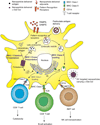Synthetic Nanoparticles for Vaccines and Immunotherapy
- PMID: 26154342
- PMCID: PMC4688911
- DOI: 10.1021/acs.chemrev.5b00109
Synthetic Nanoparticles for Vaccines and Immunotherapy
Figures



















References
-
- Charles A Janeway J, Travers P, Walport M, Shlomchik MJ. Principles of Innate and Adaptive Immunity. 2001
Publication types
MeSH terms
Substances
Grants and funding
LinkOut - more resources
Full Text Sources
Other Literature Sources

